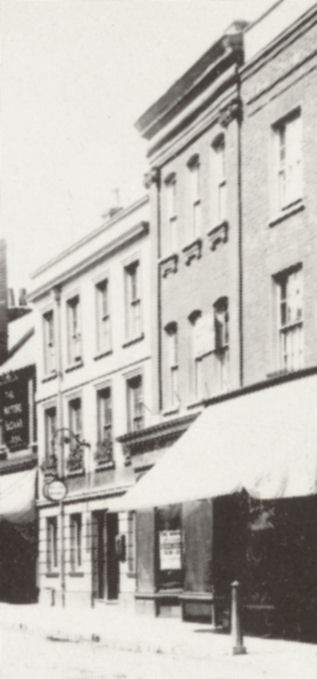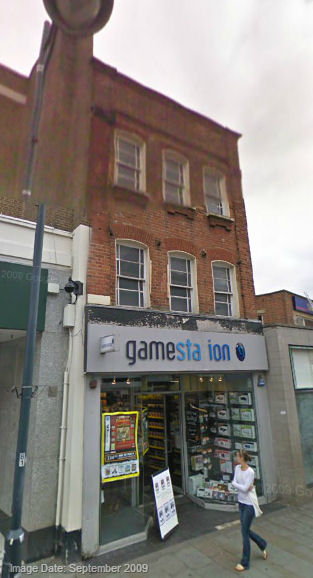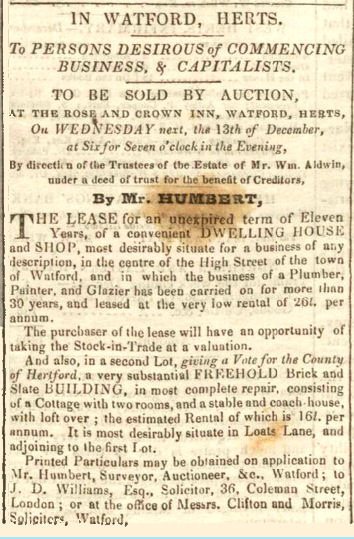|
97 High Street, Watford, Before 1853 January, 2013 |
|
||||||||
Louis Curtis (louiscur @t aol.com) writes: I am a final year Historic building conservation student based in Abbots Langley and studying in London. I am currently working on an assignment about 97 High Street Watford. I have spent a lot of time researching and have so far not been able to come up with a date for construction. The listing states it was built in the early 18th Century but I have not been able to narrow that date down. Most of the history I have found starts in the Downer era (your website has been most useful) beginning in 1853 which leaves a possible 100-150 years previous with no information.
Any guidance you could give in relation to finding construction dates, the architect or the period before Downer would be greatly appreciated.
|
Google Street View - Image September 2009 |
Before I go any further lets put the building in context. 97 High Street is squeezed between a major 20th century shop - Marks and Spencers and a smaller 20th century development. The property acquired by the Downer family in 1853 consisted of a shop with two floors above, and the extensive grounds at the rear includes a cottage, stabling, a coach house, and access to Loates Lane. (See Biography of Frederick Downer.) The 1766 map shows Loates Lane entering Watford High Street opposite the parish church. |
Detail from Dury & Andrew's Map of Hertfordshire, 1766 |
|
From the photographic record of the High Street in The Book of Watford (second edition, 2003) Note that what is left of this end of Loates Lane is a narrow gap between modern buildings that preserves the slight curve to the left shown in the 1766 map |
||
|
Finding early information on the history of a site such as this is complicated by the fact that street numbers were only introduced in Watford in Victorian times and that earlier references will, except in the case of places such as inns and public houses, refer to the property by the name of the owner and/or tenant, by references to the owners and/or tenants of neighbouring plots, and in descriptive terms. This plot, at least when the Downer family were there, had the distinctive feature that it fronted on the High Street AND Loates Lane.
Normally the starting point is whether the old deeds still exist and the current owner of the property may know. There may also be some information relating to the documentation used when listing the building.
There may also be a tithe map for Watford from around 1840 and you should try HALS, who may also have some other sources. I am sure you already know Watford Library has some useful resources.
The picture on the right comes from a post card dated about 1905. à |
 |
|
I decided to try what might be considered a very long shot and did a search for "Loates Lane" on the British Newspaper Archive and, much to my surprise, came up with "gold". The advert on the right come from the Hertford Mercury and advertises the sale of property by auction on the 11th October, 1842. The owner of the property was the late Thomas Pearce Taylor. The following extract fits the description of the property occupied by the Downer family in about 1853. It refers to the sale of a comparatively significant building at £26 rental per annum, facing Watford High Street, with a cottage with stables facing on Loat's Lane. (Note the wording - If the property was on the corner of Loates Lane the natural way to describe it would be to say it was on the corner with the cottage adjoining - so the advert is not describing the corner plot!) |
Hertford Mercury 8th October, 1842. |
|
|
|
|
The advert tells us that in 1842 the house was occupied by William Aldwin, the cottage was occupied by Mary Rowles, and both had been owned by the late Thomas Pearce Taylor. This allows us to identify William and his family in the 1841 census: |
||||||||||||||||||||||||||||||||||
|
Hertford Mercury 9th December, 1843 |
Fortunately (for this research) it seems that William Aldwin had died and his estate was being wound up. A year later the advert on the left from the Hertford Mercury of 9th December 1843 reveals that the lease came onto the market, together with that of the cottage. It provides the information that William (and presumably before him his father, husband of widow Sarah Aldwin) have carried out their plumbing business on the premises for over thirty years. The fact that the census shows that William was not born in Hertfordshire suggests the Aldwin business only started in Watford after William had been born. So we now know there was a tenancy change in the property in about 1810 in 1843. It also shows that the lease had about 11 years to run, and and we already know that the Downer family moved in about 10 years later. We do not know who took the lease, but this information can probably be obtainable from the 1851 census, and similar information may be available on the occupant of the cottage. |
|||||||||||||||||||||||||||||||||
|
You should be able to find out William Aldwin's father's name from Pigot's directories for 1823, and 1828/9. The above information appears to have taken us past an awkward gap in records as once you have owner/tenancy information in 1830 it may well be possible to follow changes in owner/tenancy back year by year from 1830 to 1753 using the Watford land tax records. (In practice start by looking to see when the Aldwin name first appears circa 1810.) Land tax records are held at HALS and are hard work - as to follow ownership and tenancy changes you need to compare successive years. However once you have names you may find HALS has relevant documents in which the property can only be describe because of its ownership, rather than by a description.
An additional problem is that even if you can trace the owners/tenants back there may be no records about the actual building. However there is one interesting line than might be worth following up. The later advert says that the cottage gives a vote for the County of Hertford. This suggests to me that the cottage is part of an original significant property on a plot with an open front to the High Street. At some date (in the 18th century?) two commercial properties, one being the house you are researching, and the other the one on the corner of Loates Lane, were built facing the High Street on the "front garden" of the original property. At the very least it could be worth checking with HALS to see if any of the names you have appear in any 18th century poll books.
If the house was built in the 18th century who built it? The militia lists, which cover the later part of the 18th century includes some occupations. (HALS has them, and there is a CD produced by the Herts FHS) Relevant occupations I spotted were brickmaker, bricklayer, carpenter, glazier, joiner, plasterer, plumber and stone mason. Within Hertfordshire there is only one mention of an architect in the militia lists and only six parishes boasted a builder. I suspect that many buildings were built by the local bricklayer (for brick buildings) or carpenters (for wood-framed buildings) perhaps working from some kind of pattern book (as I know carpenters making furniture did) and there was no architect involved. |
||||||||||||||||||||||||||||||||||




.jpg)
.jpg)
